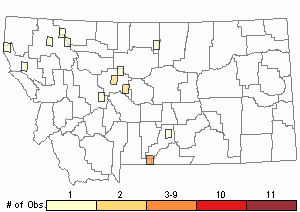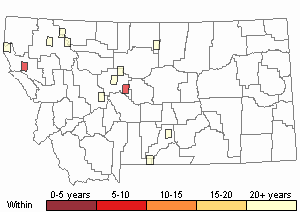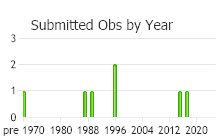View in other NatureServe Network Field Guides
NatureServe
Montana
Utah
Wyoming
Idaho
Wisconsin
British Columbia
South Carolina
Yukon
California
New York
Hymenostylium Moss - Hymenostylium recurvirostrum
Other Names:
Hymenostylium recurvirostre
General Description
Plants: Acrocarpous (Vitt 1988), growing in crowded, mat-like clumps, green or green with yellow tones distally, frequently brown proximally (Lawton 1971). Stems 5-70 mm in height, thin and delicate (FNA 2007).
Leaves: Somewhat laxly spaced, slender and lance-shaped (Lawton 1971), cupped but not quite keeled (Crum & Anderson et al., 1981); margins with 1 side usually curved back and under and the other side upright; base delicately long-decurrent; costa ending just shy of the leaf tip or reaching it, sometimes shortly surpassing it to form a sudden point, sometimes of 1 cell, the costa ventral face in X-section U-shaped (FNA 2007).
Leaf Cells: Distal laminal cells variously shaped, from nearly square or slightly lengthened longitudinally to diamond-shaped, somewhat longer, particularly above and close to the costa, smaller than the basal cells; basal cells quadrangular and somewhat long, transitioning gradually, with few or no papillae on the lowermost cells, often with walls pitted and erratic in thickness; marginal laminal cells nearly square or oblong (to 3:1), not as large as adjacent cells, rarely with stretches 2 cell-layers thick, with 0-5 papillae per cell, the papillae sometimes 2-lobed (FNA 2007).
Hymenostylium recurvirostrum var. recurvirostrum: Present in Montana. Leaves spreading a little whether dry or moist, usually 1-1.6 mm in length (as long as 2 mm), the base not abruptly widening (may be egg-shaped but shoulders not present); costa in X-section faint, the ventral stereids usually 2-4 in a row (rarely none); sclerodermis of the stem rarely absent or up to 3 cell-layers in thickness (FNA 2007).
Hymenostylium recurvirostrum var. insigne: Leaves upright or spreading slightly when dry, spreading ca 90 degrees with the ends curved back and downward when moist, 1.6-2.4 mm in length, the base abruptly widened below, forming shoulders; costa in X-section well-developed, the ventral stereids 6-10 in a row; sclerodermis of the stem 3-5 cell-layers thick (FNA 2007).
Diagnostic Characteristics
Gymnostomum aeruginosum, also attracted to water and limestone, often has oblong leaves that do not taper, unlike the leaves of Hymenostylium recurvirostrum. It also has ventral superficial cells of the costa that are square and papillose, only being somewhat long in very compact leaves; those of H. recurvirostrum are typically long and slender, without papillae (FNA 2007).
Range Comments
North American Range
Hymenostylium recurvirostrum var. recurvirostrum: In Canada from YT to NU, BC to NL and NS (except SK and PE); in the USA know from AK and most continental states except absent in ND, NE to OK, LA to SC, and a few other scattered states; Mexico (FNA 2007). Known in Montana from Big Horn, Cascade, Flathead, Glacier, Hill, Lewis and Clark, Park, and Stillwater Counties (Elliott & Pipp, 2016).
Hymenostylium recurvirostrum var. insigne: Known only in Canada from BC (FNA 2007).
Observations in Montana Natural Heritage Program Database
Number of Observations: 22
(Click on the following maps and charts to see full sized version)
Map Help and Descriptions
Relative Density

Recency



 (Observations spanning multiple months or years are excluded from time charts)
(Observations spanning multiple months or years are excluded from time charts)
Habitat
Hymenostylium recurvirostrum: Wet or damp soil and calcareous stone of cliffs, shelves and fissures, by waterfalls and water courses; calciphilic. Ranging in elevation from 0 to 6230 feet (FNA 2007).
Hymenostylium recurvirostrum var. insigne: Moist, calcareous cliffs. Ranging in elevation from 0 to 3280 feet (FNA 2007).
Reproductive Characteristics
Dioicous. Perigonia bud-like, situated at the top of stem apices or laterally below. Seta yellow, eventually turning russet-colored, spiraled, 4-10 mm tall. Capsule yellow to russet in color (FNA 2007), glossy (Crum & Anderson et al., 1981); theca 0.5-1 mm in length, with a broad opening when dry; operculum sometimes joined to the columella (FNA 2007), the beak askew (Lawton 1971); peristome lacking. Calyptra cowl-like, approximately 1-1.5 mm in length (FNA 2007).
Stewardship Responsibility
References
- Literature Cited AboveLegend:
 View Online Publication
View Online Publication Crum, H.A. and L.E. Anderson. 1981. Mosses of Eastern North America. 2 volumes. Columbia University Press, New York. 1328 pp.
Crum, H.A. and L.E. Anderson. 1981. Mosses of Eastern North America. 2 volumes. Columbia University Press, New York. 1328 pp. Elliott, J.C. and A.K. Pipp. 2018. A Checklist of Montana Mosses (1880-2018). Updated 3 January, 2020. Montana Natural Heritage Program, Helena, Montana. 73 pp.
Elliott, J.C. and A.K. Pipp. 2018. A Checklist of Montana Mosses (1880-2018). Updated 3 January, 2020. Montana Natural Heritage Program, Helena, Montana. 73 pp. Flora of North America Editorial Committee, eds. 2007. Flora of North America North of Mexico. Volume 27. Bryophytes: Mosses, Part 1. Oxford University Press, Inc., NY. xxi + 713 pp.
Flora of North America Editorial Committee, eds. 2007. Flora of North America North of Mexico. Volume 27. Bryophytes: Mosses, Part 1. Oxford University Press, Inc., NY. xxi + 713 pp. Lawton, E. 1971. Moss Flora of the Pacific Northwest. Hattori Botanical Laboratory. Japan: Yamabuki-cho, Shinjuku-ku, Tokyo. 362 pages plus appendices.
Lawton, E. 1971. Moss Flora of the Pacific Northwest. Hattori Botanical Laboratory. Japan: Yamabuki-cho, Shinjuku-ku, Tokyo. 362 pages plus appendices. Vitt, D. J. Marsh, and R. Bovey. 1988. Mosses, Lichens & Ferns of Northwest North America. Seattle, WA: University of Washington Press. 296 p.
Vitt, D. J. Marsh, and R. Bovey. 1988. Mosses, Lichens & Ferns of Northwest North America. Seattle, WA: University of Washington Press. 296 p.
- Additional ReferencesLegend:
 View Online Publication
View Online Publication
Do you know of a citation we're missing? Elliot, J. C. 1993. Second checklist of Montana mosses. Unpublished report. U.S. Forest Service, Region 1. Missoula, MT. 45 pp.
Elliot, J. C. 1993. Second checklist of Montana mosses. Unpublished report. U.S. Forest Service, Region 1. Missoula, MT. 45 pp. Flowers, S. 1973. Mosses: Utah and the West. Brigham Young University, Provo, Utah. 567 p.
Flowers, S. 1973. Mosses: Utah and the West. Brigham Young University, Provo, Utah. 567 p. Lawton, E. 1971. Keys for the Identification of the Mosses on the Pacific Northwest. Reprinted from 'Moss Flora of the Pacific Northwest'. Published as Supplement No. 2 of the Journal of the Hattori Botanical Laboratory. Nichinan, Miyazaki, Japan. 66 pp.
Lawton, E. 1971. Keys for the Identification of the Mosses on the Pacific Northwest. Reprinted from 'Moss Flora of the Pacific Northwest'. Published as Supplement No. 2 of the Journal of the Hattori Botanical Laboratory. Nichinan, Miyazaki, Japan. 66 pp. Smith, A.J.E. 1980. The Moss Flora of Britain and Ireland. Cambridge University Press, Cambridge. 705 pp.
Smith, A.J.E. 1980. The Moss Flora of Britain and Ireland. Cambridge University Press, Cambridge. 705 pp.
- Web Search Engines for Articles on "Hymenostylium Moss"





